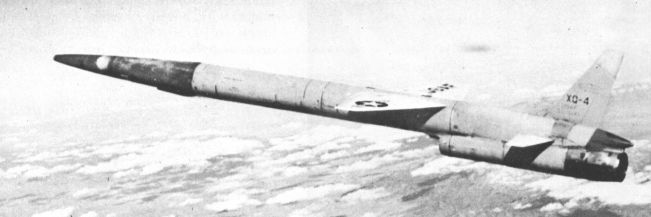Northrop (Radioplane) Q-4/AQM-35
In 1953, Northrop's Radioplane division started the development of the Model RP-61 supersonic target drone, and in June 1954 the USAF awarded a contract for the Q-4 vehicle under project MX-2144. The first air launch of an XQ-4 aircraft occurred in January 1956, and although the XQ-4 had a ground-launch capability, this was never used.
The XQ-4 was powered by an XJ81-WE-3 turbojet engine, and could reach a speed of Mach 1.55. It was air-launched by B-50D or GC-130A aircraft, and was controlled by a radio-command guidance system. The drone was tracked by radar, and a telemetry system was used to transmit flight parameters in real time. The XQ-4 could be recovered by a three-stage parachute system and was equipped with four inflatable bags which softened the landing to prevent damage to the airframe. The Q-4 was planned to be used to test various types of air-to-air and surface-to-air missiles designed for use against supersonic enemy aircraft. Optionally, it could also be fitted with photographic or TV reconnaissance equipment.
 |
| Photo: USAF |
| XQ-4 |
The XQ-4A was specifically designed to meet the radar-appearance requirements for testing the IM-99/CIM-10 Bomarc missile. It was to use the Fairchild J83 engine, but was cancelled when the latter didn't become available in time. In February 1959, the USAF awarded Radioplane a contract for the much improved Q-4B model, and the first flight of an XQ-4B occurred in March 1961. Some sources state that the XQ-4B vehicles were actually built by Bendix. The XQ-4B had improved performance using the significantly more powerful J85-GE-5 engine and a slightly redesigned airframe.
 |
| Photo: Northrop |
| XQ-4B (AQM-35B) |
In June 1963, the Q-4 and Q-4B were redesignated as AQM-35A and AQM-35B, respectively. However, the Q-4/AQM-35 never became fully operational with the USAF, and only 25 XQ-4/Q-4B missiles were built. Quoted reasons for the cancellation include problems during development and flight-test, and the fact that the AQM-35's performance was too high for the surface-to-air missiles of the early 1960s anyway. The AQM-35 had apparently been removed from the inventory by the mid-1960s.
Note: There are a few sources which call the AQM-35 the "Bendix Talos" and/or refer to RIM-35A or RTM-35A designations. I don't know the origin of these reports, but they are certainly erroneous. There is no way a variant of the AQM-35 could have been built as a ship-launched interceptor missile, and I strongly suspect some major confusion between the Bendix-built AQM-35B and that company's RIM-8 Talos ship-based air-defense missile.
Specifications
Note: Data given by several sources show slight variations. Figures given below may therefore be inaccurate!
Data for XQ-4, Q-4B (AQM-35B):
| XQ-4 | Q-4B (AQM-35B) | |
|---|---|---|
| Length | 10.06 m (33 ft) | 10.77 m (35 ft 4 in) |
| Wingspan | 3.38 m (11 ft 1 in) | 3.86 m (12 ft 8 in) |
| Diameter | 51 cm (20 in) | |
| Height | 1.69 m (5 ft 6.7 in) | 1.88 m (6 ft 2 in) |
| Weight | 900 kg (1985 kg) | 1540 kg (3400 lb) |
| Speed | Mach 1.55 | Mach 2 |
| Ceiling | 18300 m (60000 ft) | 21300 m (70000 ft) |
| Propulsion | Westinghouse XJ81-WE-3 turbojet; 8.0 kN (1810 lb) | General Electric J85-GE-5 turbojet; 17.1 kN (3850 lb) |
Main Sources
[1] Richard A. Botzum: "50 Years of Target Drone Aircraft", Northrop, 1985
[2] Frederick I. Ordway III, Ronald C. Wakeford: "International Missile and Spacecraft Guide", McGraw-Hill, 1960
[3] Norman J. Bowman: "The Handbook of Rockets and Guided Missiles", Perastadion Press, 1963
Back to Current Designations Of U.S. Unmanned Military Aerospace Vehicles
Back to Directory of U.S. Military Rockets and Missiles
Last Updated: 19 January 2003